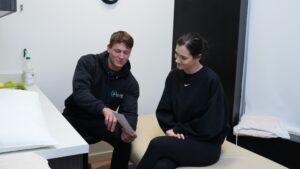
Restless legs syndrome (RLS) is a condition that causes an uncontrollable urge to move the legs, usually because of an uncomfortable sensation. It is a neurological syndrome that is not well understood but affects 3-5 % of the adult population. Sometimes known as Willis-Ekbom Syndrome, RLS can begin at any age and tends to worsen as you age. It most commonly occurs in the evening hours when you’re sitting or lying down.
Most patients describe the sensation of restless leg syndrome as a creeping, crawling, throbbing, aching, itching, pulling, or electric or feeling within the limb.
Restless leg syndrome is known in two forms:
- Primary RLS has a strong genetic link, affects women 2:1 vs men, and comes on before age 45.
- Secondary RLS has an onset after age 45, typically has more severe symptoms and faster progression, and men and women are approximately equally affected.
Simple self-care steps and lifestyle changes may help relieve symptoms. Medications also help many people with RLS.
What are the symptoms of RLS?
The main symptom is an urge to move the legs. Common accompanying characteristics of restless leg syndrome include:
- Relief with movement: The sensation of RLS lessens with movement, such as stretching, jiggling the legs, pacing, or walking.
- Sensations that begin while resting: The sensation typically begins after you’ve been lying down or sitting for an extended time, such as in a car, airplane, or theatre.
- Nighttime leg twitching: RLS may be associated with another, more common condition called periodic limb movement of sleep, which causes the legs to twitch and kick, possibly throughout the night, while you sleep.
- Worsening of symptoms in the evening: Symptoms occur mainly at night.
Causes of RLS
There’s no concrete, known cause for RLS. Researchers suspect the condition may be caused by an imbalance of the brain chemical dopamine, which sends messages to control muscle movement.
Pregnancy
Pregnancy or hormonal changes can temporarily worsen restless leg syndrome symptoms and signs. Some women get RLS for the first-time during pregnancy, especially during their last trimester. However, symptoms tend to disappear after delivery.
Heredity
RLS can runsin families, especially if the condition starts before age 40. Researchers have identified sites on the chromosomes where genes for RLS may be present.
How physiotherapy can help with RLS
One study looking at exercise showed a significant improvement in RLS symptoms with the addition of strengthening and cardiovascular conditioning three times a week.
28 participants were supervised for 12 weeks and RLS severity scores dropped 39% compared to baseline scores. The control group had 8% lower scores. Exercise is a relatively unresearched modality for RLS, despite poor cardiovascular conditioning being associated with more severe symptoms.
A physiotherapist can work with patients to develop an exercise program tailored to your personal needs.
Conditions that can accompany restless leg syndrome.
RLS usually isn’t related to a serious underlying medical problem. However, it sometimes accompanies other conditions, such as:
Iron deficiency. Even without anemia, iron deficiency can cause or worsen RLS.
Peripheral neuropathy. This damage to the nerves in the hands and feet is sometimes due to chronic diseases such as diabetes and alcoholism.
Kidney failure. When your kidneys don’t function properly, iron stores in the blood can decrease. This and other changes in body chemistry can cause or worsen RLS.
Parkinson’s disease. People with Parkinson’s disease and take dopaminergic agonists have an increased risk of developing RLS.
Spinal cord conditions. Lesions on the spinal cord because of damage or injury have been linked to RLS. Having had anesthesia to the spinal cord, such as a spinal block, also increases the risk of developing restless leg syndrome.
What you should avoid with RLS.
Caffeine, nicotine, and alcohol have all been shown to increase RLS symptoms, and are best to avoid, especially late in the day. It is helpful to maintain a regular sleep pattern. It also may be useful to try warm baths before sleep.
If you are suffering from restless leg syndrome and would like to book in with one of our experienced physiotherapists, book a same-day appointment today.








